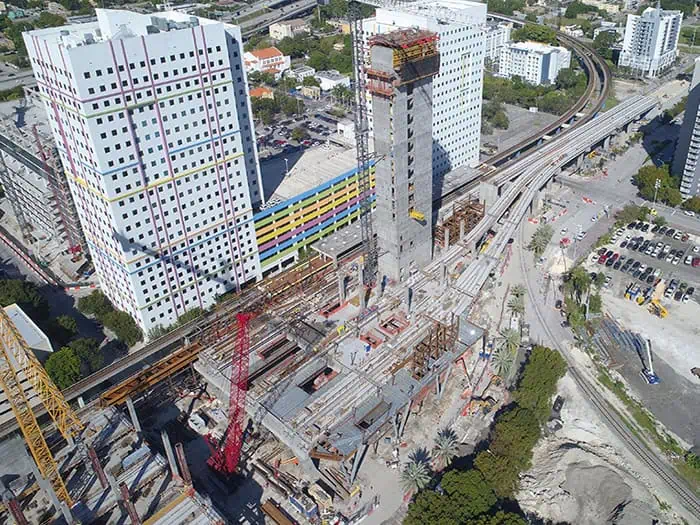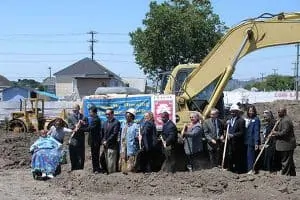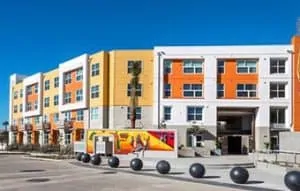


Recycling land and properties helps build opportunities for creating and transitioning commercial and mixed-use space. It is often a sensible and sustainable option with rising real estate costs, increased due diligence, and a lack of greenfield in and around urban areas with established infrastructure.
Miami-Dade County, nestled between the Atlantic Ocean and the Everglades in Florida, faces a significant challenge in finding space for new development. With land becoming increasingly scarce, attention has turned towards redeveloping sites left vacant due to contamination or the perceived presence of contamination, such as brownfield designated areas, agricultural lands, golf courses, old dumps, and closed landfills.
Despite the challenges these sites pose, such as contamination from pesticides, herbicides, and other pollutants, developers and investors are finding many benefits to redeveloping these sites for residential, mixed-use, and commercial purposes.
Sustainable Benefits for Developers, Investors, Local Businesses, and Communities
Increased Community Value: Vacant, contaminated sites offer little benefit to communities. Redeveloping these areas can transform them into safe, productive commercial or mixed-use spaces, contributing to revitalization and community well-being.
Job Creation: Redevelopment projects stimulate economic activity by creating jobs in construction, engineering, and related fields. Jobs boost local employment rates and support businesses in the area.
Tax Revenue: Land recycling can increase property values and tax revenues for essential community services such as schools, roads, and public facilities.
Tax Credits: Private and public entities conducting voluntary cleanup in Florida, for example, can receive available tax credits of upwards of $500,000.
Federal Funding: EPA’s Brownfields Program provides direct funding via grants for assessment, cleanup, and other environmental-related programs.
Affordable Housing: Repurposing land for residential use can help address housing shortages, offering more affordable housing options in desirable urban and suburban locations.
Environmental Restoration: Through careful planning and adherence to regulations, redeveloped sites can contribute to environmental restoration efforts. Measures like methane gas mitigation systems manage any environmental risks responsibly.
Solutions to the Most Common Challenges
Although redeveloping contaminated properties or land recycling offers benefits, some challenges require insight from specialized environmental engineers. With their more comprehensive knowledge and relationships, these engineers help keep projects safe and on schedule.
Costs and Monetary Support: Assessment and remediation costs are typically the number one factor in why sites are not recycled. However, engaging an environmental program manager who guides you through state and federal funding options can help achieve budgetary goals by offsetting some of these costs.
Regulatory Compliance: Regulations for redeveloping sites are stringent and require experienced professionals who understand the regulatory landscape. Therefore, engaging with an engineer early to perform due diligence will help better qualify and quantify development risks. The same professional can better provide the development team with the closure strategies available to manage and mitigate contaminants effectively.
Risk Management: Risk-based corrective actions (RBCA) are crucial in ensuring the safety of redeveloped sites and land recycling. Without RBCA, many contaminated sites would likely be undeveloped due to high remediation costs. The engineer will tailor actions to a specific county or city regulatory framework to address potential hazards comprehensively. Specialized techniques environmental engineers use include newer technology and engineering processes that can resolve contamination and groundwater issues more efficiently while meeting local, state, and federal mandates.
Innovation and Adaptation: Staying ahead of emerging contaminant challenges such as per- and polyfluoroalkyl substances (PFAS) or remediation limitations is essential as regulatory landscapes evolve. Adapting to new cleanup standards and remediation technologies ensures that redeveloped sites meet or exceed environmental safety expectations both now and in the future. It is also possible for some land recycling projects to account for or verify any carbon savings – an increasingly important consideration to shareholders.
Exploration into Land Recycling and Property Restoration is Rigorous
Redeveloping contaminated land presents both challenges and opportunities. Developers are transforming these sites into valuable community assets by adhering to rigorous environmental standards and employing innovative solutions. From economic revitalization to environmental stewardship, redeveloping contaminated properties or land recycling offers a path toward sustainable growth and improved quality of life in regions around our nation.
Meet the Authors:


Additional Land Recycling Resources:
At SCS, we’re proud that our services, vision, and corporate citizenship support community revitalization through brownfield redevelopment and land reuse.
The U.S. Environmental Protection Agency in 2017 estimated that roughly 40 percent of all Americans, including a quarter of all children, live within 3 miles of a brownfield site that has received EPA funding. This is a conservative estimate, as only 5.5% of brownfields nationwide have benefited from EPA resources. But these striking numbers clarify the degree to which remediating and repurposing contaminated and underutilized properties has transformative potential to protect our residents’ health and safety.
SCS firmly believes that all blighted, abandoned, and underutilized properties have a future as community assets. We support this vision through the services we provide as well as through our corporate citizenship. The partnership of SCS technology and environmental know-how with CCLR is powerful. There is no shortage of possibilities for brownfields now; ski resorts, parks, mixed-use properties, solar farms, really almost any infrastructure is possible.
SCS is proud to support the Center for Creative Land Recycling (CCLR, or “See Clear”), the leading national nonprofit dedicated to transforming communities through land recycling. Over the past two decades, CCLR has convened, navigated, and influenced the redevelopment industry. Their programs educate the public and community stakeholders to clean up and repurpose underutilized and environmentally impacted properties in a sustainable, equitable and responsible manner.
CCLR and SCS share the belief that with the right training, incentives, and conditions — chiefly, an active corporate partner/investor, community support, and municipal leadership — the redevelopment of brownfields changes communities for the better. CCLR has produced two videos, “About CCLR” and “What is Land Recycling?,” which provide important perspectives about CCLR’s mission and accomplishments.
Dan Johnson, Jim Ritchie, and Amy Dzialowski are among the SCS staff who have worked with CCLR. They have spoken on panels at CCLR’s California Land Recycling Conference, participated in vapor intrusion study groups, teamed with CCLR on providing technical support to West Sacramento and other municipalities, and serve on the planning committee for the Brownfields 2021 Conference together.

For more information about CCLR, brownfields, and property remediation, contact , or Jean Hamerman, Acting Executive Director of CCLR.
Landfill Sites are Finding Second Lives as Real Estate Properties
Innovative projects have sprung up over the years that house retail, apartments, golf courses, conference centers and hotels. Engineers in the solid waste space are applying several structural design techniques that other industries have leveraged for years like building on piles, which has historically been done on marshlands and other unstable ground. They’re also designing floating foundations that allow for movement and making adjustments when differential settlements happen.
Over the years, SCS has designed landfill-related systems for dozens of projects, mainly apartments, business complexes, entertainment complexes, hotels, parks and golf courses. In the past three years,SCS has fielded calls from developers looking into options, resulting in projects moving into the development stages. From small to the largest landfill redevelopment project in the nation , this article gets you started and leads to more information.
SCS’s environmental services supporting COMM22, a mixed-use, mixed-income redevelopment project in San Diego will be recognized at Environmental Industry Summit XV

When the Environmental Business Journal (EBJ) presents its 19th annual Business Achievement awards this March, SCS Engineers will receive an award of Project Merit: Redevelopment, for its investigation and design program for COMM22, a multi-family residential development by BRIDGE Housing.
COMM22 is a mixed-use, mixed-income, transit-oriented development built on a former bus maintenance facility. SCS addressed several issues including underground storage tanks and the testing of fill soils. The firm’s pre-construction characterization and three-dimensional data analysis resulted in time and budget savings.
“Our remediation effort on this property ensured that human health and the environment were protected as cost-effectively as possible,” said Dan Johnson, vice president of SCS. “Affordable housing is important to San Diego communities and we applaud the work of BRIDGE Housing and the collaboration it takes to create urban projects like this.”
BRIDGE Housing Corporation, a leading nonprofit developer of affordable housing, creates and manages a range of high-quality, affordable homes for working families and seniors. Since it was founded in 1983, BRIDGE has participated in the development of over 16,000 homes in California and the Pacific Northwest.
More award-winning redevelopment projects of interest:
Petco Park and East Redevelopment – San Diego
Emerald Ridge Homes – East Alton
NFL Stadium Site – Los Angeles
Commercial Real Estate Transactions blog